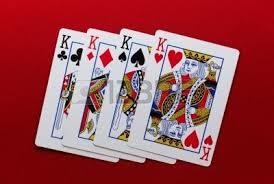The picture may say something..!!
 One Card is drawn from
5
2
playing cards. What is the probability that the card will be a RED CARD or KING ?
One Card is drawn from
5
2
playing cards. What is the probability that the card will be a RED CARD or KING ?
You can try my other Probability problems by clicking here
This section requires Javascript.
You are seeing this because something didn't load right. We suggest you, (a) try
refreshing the page, (b) enabling javascript if it is disabled on your browser and,
finally, (c)
loading the
non-javascript version of this page
. We're sorry about the hassle.
4 solutions
Event ( A ) Red card = 2 6
Event ( B ) King cards = 4
( A ∪ B ) = 2
P ( A ∪ B ) = 5 2 2 6 + 4 − 2 = 5 2 2 8 = 1 3 7
You may want to use \dfrac{..}{..} to get bigger fractions. See I have edited your solution.
out of 52 cards there are 26 cards of red color i.e. probability is 26/52 out of 52 cards there are 4 cards of kings i.e. probability is 4/52 now there are 2 king cards which are red in color i.e.probability is 2/52 ACCORDING TO ADDITION THEOREM P(A OR B)==P(A) +P(B) - P(A AND B) i.e. =====26/52 + 4/52 - 2/52 == 28/52==7/13
Red cards are 26. Kings that aren't Red are two. So the probability we are looking for is 28/56=7/13.
*28/52 not 28/56
I think the question should be RED CARD or RED KING.
Log in to reply
Then there wouldn't be a point in asking the question because red kings are red cards, so it would just be one half as probability.
L e t P ( A ) b e t h e p r o b a b i l i t y o f g e t t i n g r e d c a r d s o u t o f t h e d e c k , L e t P ( B ) b e t h e p r o b a b i l i t y o f g e t t i n g k i n g s o u t o f t h e d e c k a n d L e t P ( A + B ) b e t h e p r o b a b i l i t y o f g e t t i n g a k i n g o r r e d c a r d P ( A ) = 5 2 2 6 P ( A ∩ B ) = P ( A ) . P ( B ) ∴ P ( A ∩ B ) = 5 2 2 P ( B ) = 5 2 4 P ( A + B ) = P ( A ) + P ( B ) − P ( A ∩ B ) = 5 2 2 6 + 5 2 4 − 5 2 2 = 5 2 2 6 + 4 − 2 = 5 2 2 8 ∴ P ( A + B ) = 1 3 7 [ A n s w e r ]